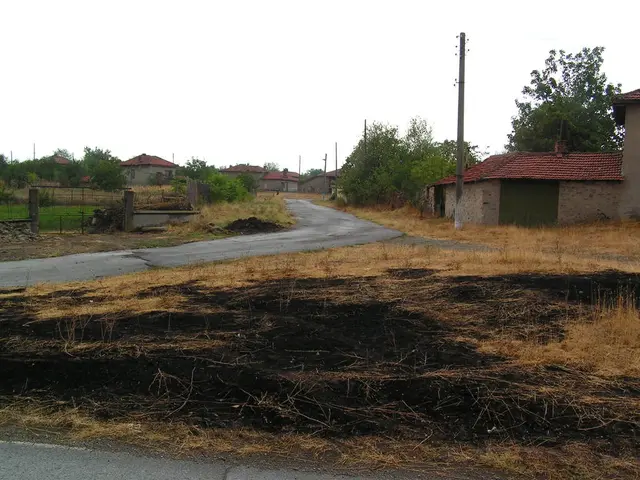Strategies for Securing Yourself Against Tick Bites
Preventing Tick Bites in Yakutia, Russia
Tick bites have become a pressing concern in rural areas of Yakutia, a region in Siberia, particularly during the active season that spans from April to October. With climate change, the range of ticks in Yakutia is expanding annually, reaching districts like Kobyaysky and Ust-Maysky. According to the Yakutia branch of Rospotrebnadzor, bites are recorded in over 20 districts across the republic.
These arachnids are neither imported nor found in high trees. They primarily inhabit grass and shrubs. Valentina Grigoryeva, Deputy Head of the Epidemiological Surveillance Department of the Yakutia branch of Rospotrebnadzor, explains that ticks attach their legs and mouthparts to clothing and crawl upwards until they find a hidden spot on the skin, often preferring the groin, armpits, and skin behind the ears.
To avoid encounters with ticks, dress appropriately when venturing into tick-infested areas. Wear light-colored, long-sleeved shirts with elastic cuffs, long pants that are tucked into socks with tight elastic bands, and high footwear. Accessorize with a hood, tie your hair under a scarf or bandana, and consider treating your clothing with acaricides, repellents, or acaricide-repellent combinations for added protection. Regularly check your clothing and each other for ticks every 15-20 minutes during outdoor activities.
Upon returning home, carefully inspect all items, including bags, blankets, scarves, clothing, and your pet if it accompanied you. If a tick is discovered on your body, seek immediate medical attention to have it safely removed. The tick will then be sent to a lab for testing, and if necessary, you'll receive tick-borne encephalitis immunoglobulin within four days of the bite. Keep the tick refrigerated in a jar with a damp cotton ball until you can hand it over to medical professionals.
Tick-borne encephalitis is a dangerous disease that begins with high fever, nausea, and vomiting followed by muscle pain, paralysis, and disability or even death if treatment is delayed. To prevent infection, specialists from the Department of Preventive Disinfection of the Yakutia Center for Hygiene and Epidemiology treat public spaces in parks, children's camps, and other crowded areas with acaricide throughout the summer season.
As of May 29, there have been 116 tick bites in Yakutia, with 15 imported from other regions. Vaccination is the most effective way to protect against tick-borne encephalitis, and residents are encouraged to get vaccinated at their local clinic, regardless of the time of year. The vaccination process involves three stages, and it's recommended to get vaccinated in the fall to be prepared for the tick activity season.
Travelers planning to visit endemic regions should also get vaccinated at least a month before entering the area. Ticks are most common in the Northwestern, Ural, Siberian, and Far Eastern regions of Russia. Stay vigilant and follow safety measures when planning trips to these or other regions.
- Science has taken significant steps in studying tick-borne diseases, aiming to improve workplace-wellness and medical-condition management.
- Chronic diseases and cancer are lifelong challenges that require continuous attention and appropriate therapies-and-treatments.
- Respiratory conditions, including allergies and asthma, can be impacted by environmental factors such as pollution and climate-change.
- Maintaining digestive-health and eye-health is essential for overall well-being, particularly as we age and develop hearing impairments.
- In the realm of health-and-wellness, fitness-and-exercise play a crucial role in strengthening our bodies and boosting immune functions.
- Autoimmune-disorders are complex conditions that can affect multiple body systems and require professional diagnosis and management.
- Climate-change has far-reaching impacts, including altering the range of ticks and causing other respiratory conditions, like allergies.
- The manufacturing industry plays a crucial role in developing gadgets and equipment to aid professionals in diagnosing and treating medical-conditions.
- Mental-health is an integral part of our overall well-being, and it's important to prioritize it just as we do physical-health.
- Skin-care, including sunscreen and proper cleansing, is essential for maintaining good skin-health and preventing skin-conditions.
- Adopting a balanced diet rich in nutrition is crucial for cardiovascular-health, aiding in preventing chronic diseases and maintaining overall fitness-and-exercise.
- The industry must take climate-change into consideration when designing and manufacturing products to reduce its negative effects on health-and-wellness.
- Medicare provides essential health care coverage for many American citizens, particularly those with chronic diseases and disabilities.
- Neurological-disorders, such as Alzheimer's and Parkinson's, require continual medical research to find effective treatments and ways to manage symptoms.
- Environmental-science plays a crucial role in understanding how ticks are spread and how the range of ticks is expanding due to climate-change.
- Finance is a crucial factor in accessing quality health care and therapies, as well as in developing new treatments for chronic diseases and neurological-disorders.
- Energy consumption in the manufacturing, retail, transportation, and other industries impacts climate-change and thus contributes to the proliferation of ticks and other health-related issues.
- Cybersecurity becomes increasingly important in protecting personal and financial well-being, especially in an age where digital transactions are common.
- Lifestyle choices, such as smoking, drinking, and lack of exercise, can contribute to various health-issues, including cardiovascular-health and chronic diseases.
- Fashion-and-beauty trends often emphasize skincare products, supplements, and fitness routines to promote health-and-wellness.
- The food-and-drink industry can contribute to overall well-being by offering healthy options and educating consumers about proper nutrition.
- Investing wisely in wealth-management is essential for providing financial security and stability for future medical expenses and home-and-garden maintenance.
- Banking-and-insurance play a key role in providing financial safety during medical crises, such as those caused by tick-borne encephalitis.
- Home-and-garden supplies, such as lawn care products, can impact the environment and thus contribute to the proliferation of ticks.
- Businesses must prioritize the health and well-being of their employees, encouraging workplace-wellness programs and cycling or walking to work for environmental benefits.
- Personal-finance plays a critical role in accessing quality health care, medication, therapies, and nutritious food.
- In the era of climate-change, the importance of preserving our environment increasingly ties into issues related to health-and-wellness and public-health-education.
- Artificial-intelligence can contribute to medical research and prevention efforts, including predicting disease outbreaks and developing new therapies for mental-health, chronic diseases, and neurological-disorders.








